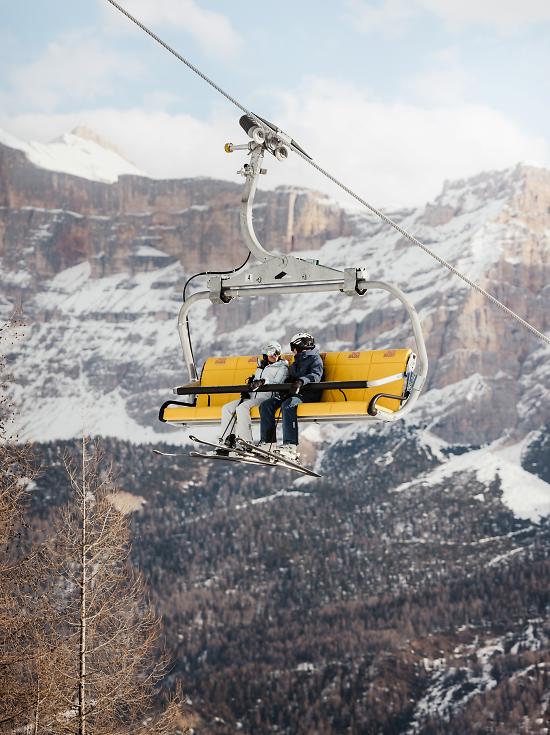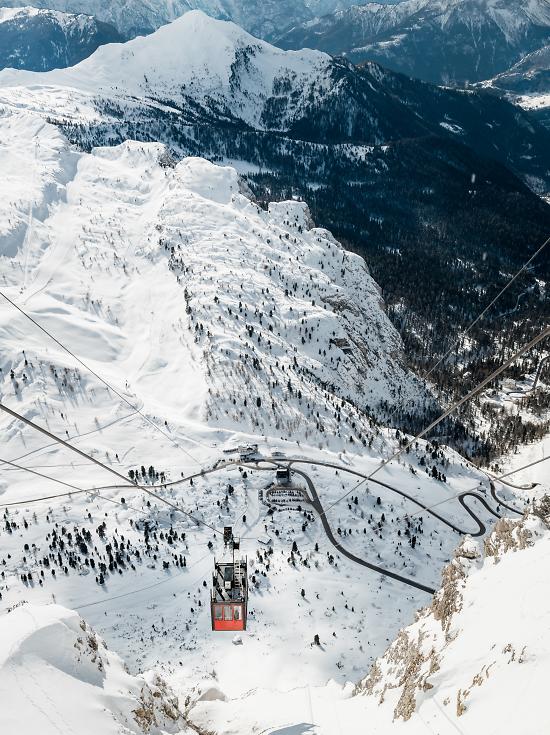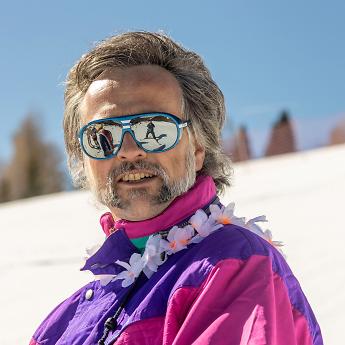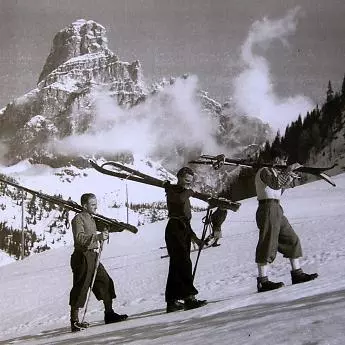
The breath of Alta Badia
Where every scene becomes a memory and every memory a lasting connection to the mountains.
Is it possible to breathe an Alpine valley, to inhale it? Not just to visit it and admire its beauty, but experience it by seeking a deeper connection, one that helps you feel that you are an integral part of the environment, overcoming the invisible boundary that separates a tourist from a guest?
The answer lies in a day in Alta Badia, where everyone can easily appreciate that this isn't a journalistic exaggeration, but a tangible experience that takes on different forms.
This applies first and foremost to ski enthusiasts, in a situation that overturns the cliché that satisfaction is measured by the number of runs and slopes you manage to ski. At the heart of this is the quality of the skiing experience. Nothing has been watered down, be in no doubt about that: there are curves, speed and excitement but everything is set in a context that heightens the sensitivity, showing that a descent can be something more than a mere athletic exercise.
Achieving this goal requires only one condition: simple, but not to be ignored. In other words, get up early and be at the La Villa cable car station before 8:30 a.m., the start time. You'll find precious few locals, a few ski instructors, and an atmosphere of thrilling anticipation for what lies ahead. The ascent to Piz La Ila on the cable cars is perfect for celebrating that ritual that skiers know well: a thin layer of cream on your face, checking your boots, adjusting your jacket and goggles, and fastening your helmet.

All these are necessary steps to be ready for the summit and be the first—or among the very first—to descend black run n. 17, the Gran Risa. Be careful: as you exit the lift, the sunlight beginning to illuminate the surrounding peaks will be a strong temptation to linger on the view. But limit yourself to a quick glance and take a deep breath - the World Cup slope awaits you; there's no time to waste.
The run is famous: the gradient of up to 69%, the harmonious progression through the forest and the changes in pace required by the various sections. But the early morning descent has an added advantage: it quite clearly marks the difference between having fun on the slopes and really breathing in a ski-run. You can tell from the first few turns: the nightly tracks of the snowcat provide an immaculate covering and perfect snow consistency, which will gradually disappear as skiers descend over the next few hours. The immediate upshot of all this is that you feel like a better skier than you actually are: a sensation that all enthusiasts crave. The reason is that this snow holds perfectly, it instils confidence and tempts you into trying different angles than you normally would. Then, it is also because you'll find yourself descending one of the most famous runs in the Alps and doing so practically alone: there's no noise to disturb you, only the pressure of your skis on the snow. It doesn't matter if the thermometer reads below zero, you don't feel the cold. You're free to turn wherever you want, at whatever speed you choose. It's just a shame that down there you can already see the end of the run.
The Gran Risa is unique, not least because of the allure generated by the performances of World Cup athletes, yet the thrilling experience it offers every ski enthusiast is by no means exclusive. This sensation of fully integrating with Alta Badia can also be felt when you head towards the Falzarego Pass. The plan is the same as before: get to Piz La Ila as quickly as possible, but instead of turning left, take the Bambi 2 slope on the right, then climb to Piz Sorega and down towards Armentarola. Without stopping, either: the goal is to quickly reach the shuttle departure point. Now, at first glance a lift in a van might clash with a narrative that emphasizes integration with the natural environment, but that's the price to pay for an excursion whose characteristics are hard to replicate.

Meanwhile, the cable car ride to the 2,778-metre peak of Lagazuoi is a genuine spectacle in its own right, thanks to the sheer verticality of the journey. It's no coincidence that it was also featured in a film from the series that makes breathtaking settings one of the secrets of its over fifty-year success: we're talking about 007, “For Your Eyes Only”, starring Roger Moore as James Bond.
Make sure the weather forecast is good, because from the hut’s terrace, the grandeur and beauty of the Dolomites will captivate you: the Tofane, Pelmo, Civetta, and Marmolada are just a few of the peaks that offer visitors a spectacular view. However, the majesty of the landscape is combined with the solemnity of history. Knowing that over a century ago, Italians and Austro-Hungarians fought each other up there, reading the reconstructions of the First World War, seeing the traces of trenches, tunnels and machine gun emplacements: all this inspires a sense of profound respect, something that is especially useful during times in which the speed of our everyday lives often leads us to ignore the past and the attention it deserves.
And skiing? Well, prepare yourself for an incredible experience. The slope isn't particularly challenging, it’s true, but where else can you ski for at least twenty minutes without coming across a single human presence, a house, a pylon or a ski lift? There’s nothing, just the welcoming embrace of the Dolomites, which takes you to an ice wall just below the Scotoni hut, where a stop is necessary in order to continue the accumulation of emotions. Then straight down to the Capanna Alpina and the flat stretch: ropes attached to the horse-drawn sleigh that is waiting to take you back to Armentarola and from there, to San Cassiano. A romantic interlude compared to the way up, before returning to the modern ski lifts and the pace to which we are accustomed.
On this journey to discover how to make skiing more than a sport or tourist activity, the Falzarego Pass offers the chance for a slight diversion. Instead of ascending by cable car, it leads you across the road and down towards Cortina. True, technically it's no longer Alta Badia, but the detour is so minimal that it's easily tolerated.
You pass through the Col Gallina area and some stretches where the quiet is an unusually valuable traveling companion. Then you'll find the lift that takes you to an ideal observation point for the Cinque Torri. And here, there's nothing to do. No matter how many times you've seen them, how familiar you are with this area: the unique architecture of the Cinque Torri has a power of attraction that overcomes all resistance and demands a few minutes of concentration.
The slope deserves at least one descent and from there, return to Col Gallina and then to the Falzarego Pass. The connection is provided by the Croda Negra chairlift, which winds between the rocks offering a truly spectacular passage.
If an early start isn't a problem and you appreciate the idea of experiencing the Alta Badia slopes with just a few close friends, then there's another experience worth planning, which is the ride up by snowmobile or snowcat before the lifts open. Some huts offer this service, enriched by breakfast at the top featuring local products. It's delicious, no doubt about it, but the truly unforgettable sensation is that of being at the top before the day officially begins: the silence is enchanting and the sky gradually takes on the colors of the day, with magical hues. Then there are glimpses of the pristine slopes; it’s a privilege to see them like this, almost asleep in the first minutes of waiting for tourists, and you get an overwhelming desire to descend and leave the first tracks.
These snapshots remain etched in your mind, memories that are even more captivating than the photos you've taken over and over again to save moments that seem unrepeatable.
It's the breath of Alta Badia.
A graduate in Political Science with an economics focus from the University of Genoa, Luca Ubaldeschi began his career as a professional journalist in 1987. He has held key editorial roles at La Stampa, and was director of Il Secolo XIX (2018–2023). Since November 2023, he heads six local newspapers in Veneto and Friuli-Venezia Giulia for Nord Est Multimedia.

Where every scene becomes a memory and every memory a lasting connection to the mountains.

Celebrating the first 40 years of the World Cup







































